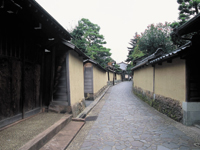Ishikawa
Back to Contents of Issue: April 2005
|
|
|
|
by Bhuvana Radhakrishnan |
|
 Of the many reasons to fall in love with Ishikawa-ken, mine are its varying seasonal moods and its bounty of cultural pursuits. A variety of activities and accommodations make Ishikawa-ken an affordable option for any Tokyoite's getaway over a three-day weekend -- suiting couples, families and the lone adventurer. For a taste of Japanese calm and natural beauty, look no further than the culturally rich Kanazawa City and the rugged Noto Peninsula. Of the many reasons to fall in love with Ishikawa-ken, mine are its varying seasonal moods and its bounty of cultural pursuits. A variety of activities and accommodations make Ishikawa-ken an affordable option for any Tokyoite's getaway over a three-day weekend -- suiting couples, families and the lone adventurer. For a taste of Japanese calm and natural beauty, look no further than the culturally rich Kanazawa City and the rugged Noto Peninsula.
Five hours by train from Tokyo, Ishikawa-ken sits in the Chubu region, facing the choppy Sea of Japan. Home to the powerful Maeda clan for over three hundred years, Ishikawa, formerly Kaga Domain, amassed and retained a cultural momentum in which silk-dyeing, lacquerware, gold-leaf handcrafts, and even Noh theater flourish to this day. Explore Japanese art and tradition by visiting a Kaga-yuzen (hand-painted silk) dyer. Traditionally combining the colors of dark red, Chinese yellow, indigo, grass green, and antique purple in patterns expressing a love of nature and folk customs, this silk is renowned for its high quality. In the final stages, some artists wash the wax and excess dye from their fabrics in local streams, a sight to truly cool the senses in summer. Kaga yuzen shows refined scenes, such as a school of fish darting through seaweed, or the arching branches of a fig tree in autumn. These functional works of art really capture the unassuming Japanese aesthetic. In Ishikawa art also meets tradition in lacquerware. Though nearby Wajima is the namesake and center of excellence for this painstaking craft, you can watch the production process in Kanazawa City also. The wood used for Wajima-nuri is dried for three to five years, after which it takes at least six months and 124 steps to produce the final product. The attention to detail is breathtaking. You can find everything from utensils like bowls and plates to delicate ornaments such as kanzashi (hair pins) -- all under numerous coats of lustrous urushi resin -- at affordable prices. But after all this man-made beauty, it is only natural to thirst for the outdoors. Kenrokuen, counted among Japan's three famous traditional gardens, is one of the few sights I have enjoyed through all four seasons in Japan. Though offering beautiful views of cherry blossoms and fall leaves, these can be obscured by hordes of other visitors. To take in the full solitude and beauty of Kenrokuen, I recommend visiting in winter, when snow caps boulders and enshrines the treetops and their twine supports to reveal the aesthetically beautiful face of Kanazawa. Winter is also the best time to reward sightseeing efforts in one of Ishikawa's better kept secrets -- the onsen of the Noto Peninsula.  The cool cobalt of the Japan Sea and its frothy sea-spray cast a conspirators' glance at the rugged face of the rocky Noto Peninsula. Compared with the Pacific Ocean, the Japan Sea is renowned for being the more brooding. Countless enka (traditional Japanese ballads) are dedicated to its rough seas, and the fishermen who try to tame them. The hard lives of the people in the fishing villages are said to imbue them with stoicism, but this is only one side of the coin, for they also possess another essential Japanese characteristic -- hospitality. Encountering foreigners, the people of these coastal villages are sometimes shocked, sometimes bored, but almost always friendly. The cool cobalt of the Japan Sea and its frothy sea-spray cast a conspirators' glance at the rugged face of the rocky Noto Peninsula. Compared with the Pacific Ocean, the Japan Sea is renowned for being the more brooding. Countless enka (traditional Japanese ballads) are dedicated to its rough seas, and the fishermen who try to tame them. The hard lives of the people in the fishing villages are said to imbue them with stoicism, but this is only one side of the coin, for they also possess another essential Japanese characteristic -- hospitality. Encountering foreigners, the people of these coastal villages are sometimes shocked, sometimes bored, but almost always friendly.
The western side of the peninsula is quieter, making it a great place to explore hot springs and fishing villages. The best way to enjoy Noto is to stay in an onsen ryokan (hot spring hotel). As you soak in an open rock pool, the expanse of the sea feels as if is yours alone. In summer you can hear the singing of crickets and laughter of children, and feel the cool sea gusts against your skin, softened by the natural chloride of the water, especially prized by women. In winter you feel flakes melt on your face as the snow muffles the sounds of your surroundings. After good seafood cooked over an irori hearth and a refreshing morning bath, it's time to return to study or work. Looking back on the living crafts in Kanazawa City, and the cool countenance of the Japan Sea, I cannot help but feel like I have visited an old friend and just learned something new. It does not take a full train ride back to Tokyo to feel that Ishikawa-ken is pondering my departure just the same way. |
|
Note: The function "email this page" is currently not supported for this page.






